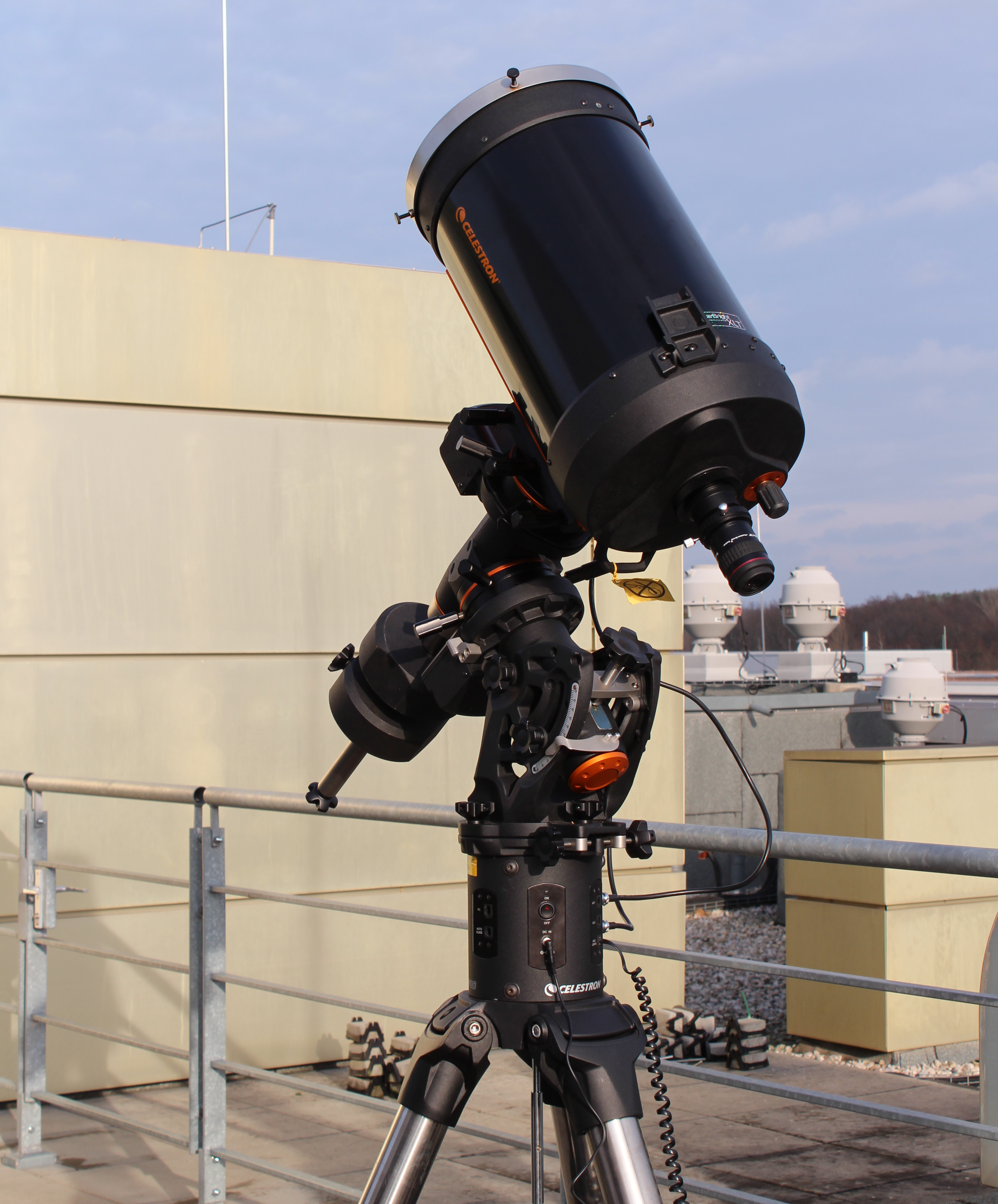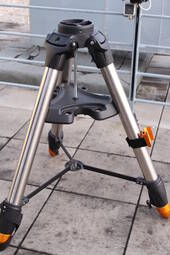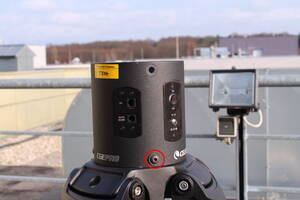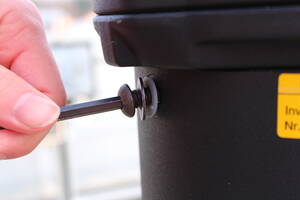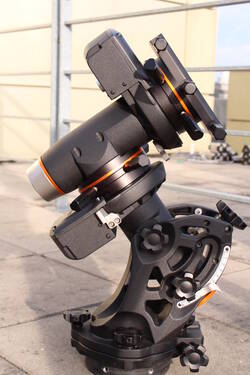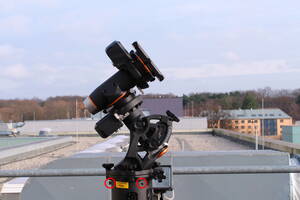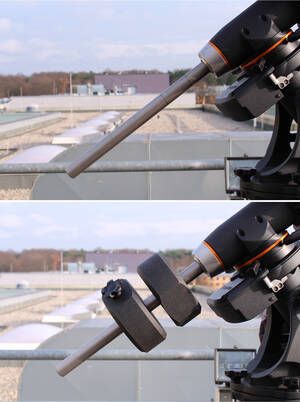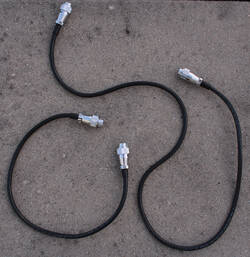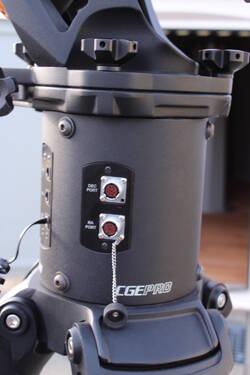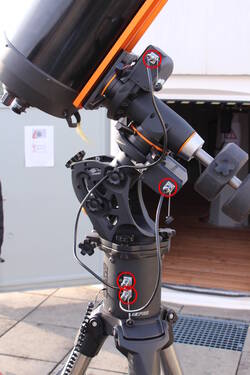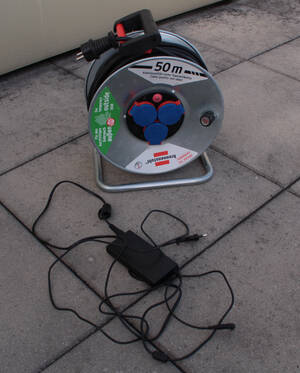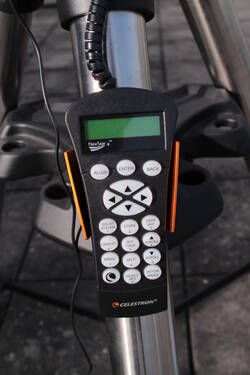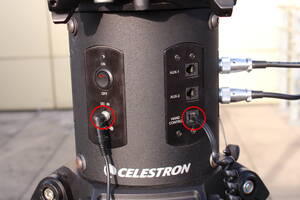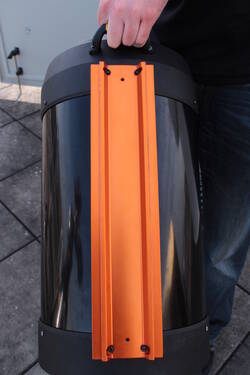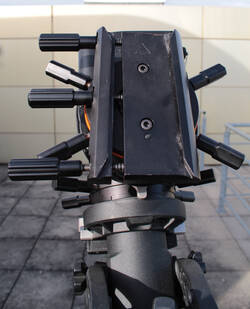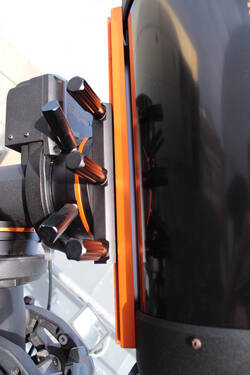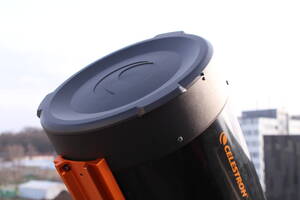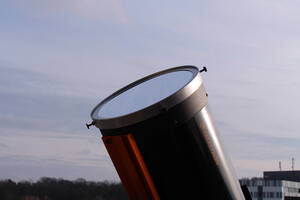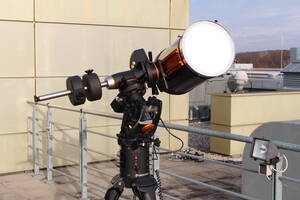Table of Contents
CGE PRO
Celestron's CGE PRO is a rugged, computer-controlled German equatorial mount suitable for both astrophotography and visual observation. With a generous payload capacity of up to 41kg, it can effectively accommodate large telescopes and heavy imaging equipment. The precision gears and motors allow for accurate tracking and alignment, although our model is getting older and no longer achieves such high precision. With autoguiding support, however, this is not noticeable. In addition, features such as the All-Star Polar Alignment and accessories such as the NexStar+ hand control and StarSense AutoAlign module allow the mount to be set up and aligned efficiently.
Individual parts
To protect the sensitive electronics from humidity and other harsh weather conditions they are stored in the lab course room.
Stored in the dome:
- the tubes (C11, RASA)
- counterweights + bar
Stored in lab course room:
- the tripop
- the CGE PROs electronic box
- the CGE PRO mount
- a box containing all 1.4″ eyepieces and the corresponding filters
- sun filters
Setup
- The CGE PRO is a parallactic mount, which has to be adjusted to point to the northern celestial pole. Therefore, the tripod (see figure 1) should be positioned accordingly. To do so, it is usually sufficient to point the tripod leg with the carrier for the hand terminal to the south.
- Screw the counterweight bar into the mechanics and place the counterweights on it (see figure 6). When you fasten the screws on them, they are hold in place.
- Connect the electronic box to the engines of the mount. The cables (see figure 7) go in the ports on the side of the electronic box (figure 8). The cables have different lengths. The short one connects electronic box with the right-ascension axis, while the longer one is for the declination axis (see figure 9). The cables only fit in one position.
- Now you can attach an eyepiece, a camera, or a spectrograph to the tube. To use 2″ oculars or one of the other instruments you need to exchange the 1.4″ adapter at the end of the tube by a 2″ adapter from the storage container.
- Often a focal reducer is already attached to the telescope. It can be easily removed, if you don't want to use it.
- Before using the telescope you have to tare the rotation axes. First lose the bolts fixing the right-ascension axis, until you can freely move the telescope around this axis. Now adjust the position of the counterweights such that there is no movement along this axis anymore. Tighten the bolts again and repeat this procedure for the declination axis. As there are no counterweights for this axis, one has to shift the tube along the clamp to tare the declination axis. Again this should be done by two people.
- Done! (figure 18)
Start-up
The CGE PRO can simply switched on and off via the On/Off switch at the electronic box. In contrast to the OST, the CGE PRO does not require any shutdown procedure. It simply can be switched off. After the boot of the mount, it is almost always required to create a new alignment. The following possibilities exist:
- Two Star Align
- One Star Align
- Solar System Align
- Quick-Align
- Last Alignment
- Re-Alignment
Unfortunately, the handling of the hand terminal of the CGE PRO is not as intuitive as the one of the OST. However, after a short settling in period even an inexperienced user can safely handle this mount.
Alignment
Usually it is required to create a new alignment after each start of the mount. If we want to use the telescope more than one night in a row, we have the opportunity to put the mount into a hibernation mode (see below) that allows to disconnect the mount from the power supply and at the same time to conserve the alignment. If the mount is used at a fixed position, one also can use a previously saved alignment.
General procedure:
- switch on the mount
- press ENTERto start the alignment procedure
- press ENTER to allow the mount to move to the initial position (the co-called switch position)
- enter the date
- enter the time
- select Daylight Savings time or Standard time
- select the time zone (+1)
- select the alignment method
In addition to the above settings one also has to set the location after a reset of the mount to the default settings. This can be done by selecting a location from a list of known locations or by entering the latitude and the longitude.
Solar System Alignment
The Solar System Alignment is useful especially for solar observations, since one can directly use the Sun to create the alignment. While the precision of the Solar System Alignment is lower than what one can achieve with an alignment procedure that is based on several stars, it is usually sufficient for solar observations. Before the Sun can be used as an alignment star, it is required to allow the telescope to actually move to the Sun because this in blocked by default for security reasons. This can be done via UTILITIES → SUN MENU → ENTER. Apart from the points mentioned above, the Solar System Alignment requires the following steps:
- select Solar System Align (with the ↑ and ↓ buttons and not with the NSWO buttons)
- select Sun in the menu and confirm it with ENTER ⇒ subsequently the telescope is moving the estimated position of the Sun
- search for the Sun and center the Sun in the eyepiece (Do not use the finderscope as suggested by the software, since we do not have a solar filter for the finderscope!)
- confirm with ENTER
- press ALIGN ⇒ Finished!
Two-Star Alignment
The Two-Star Alignment and it refinement with additional stars is the default procedure to build a new alignment for night observations. Besides the points mentioned above the following steps are necessary:
- select Two Star Align from the menu → subsequently, the telescope suggests bright stars that are above the horizon
- select and confirm the first calibration star with ENTER
- center the star in the eyepiece (the finderscope is often not very helpful, since it is most of the time not well aligned with tube)
- confirm with ENTER
- press ALIGN → afterwards the telescope suggests the second alignment star
- select and confirm the second calibration star with ENTER
- center also this star in the eyepiece (in case it is not possible to find this star, one can select a new star by pressing UNDO)
- confirm with ENTER
- press ALIGN → subsequently, the alignment can be improved with additional stars (3 are recommended, 6 are possible)
- press UNDO to complete the alignment
Hibernation
The hibernation mode offers the possibility to use the telescope several nights in a row, while switching off the power supply during the day. It ensures that the alignment will be conserved. However during hibernation, it is not allowed to move the telescope at all. The following steps are necessary to put the telescope into hibernation:
- press the MENU button
- select HILBERNATE from the UTILITES menu
- move the telescope to the desired park position
- switch off the telescope
- disconnect the power supply and arrange for weatherproof cover (Important: do not move the telescope anymore!)
Wake up:
- reconnect the power supply
- switch on the telescope
- confirm Wake up with ENTER
- confirm the time and the location
- The telescope is ready for the next observation!
Troubleshooting
Known error sources and their solutions can be found here.
Additional documentation
More details on the CGE PRO can be found in the corresponding manuals in the lab course room.
